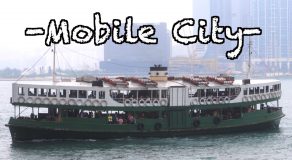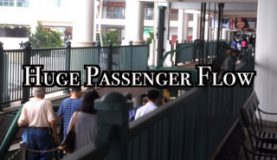
Essay:
The title of this video essay is Mobile City, which means a city that allows residents to move around quickly by various modes of transportation between urban environments. The subject of the video is to figure out one hypothesis through on-site visits and research: the star ferry plays an essential role in marine transportation in hong kong. The video showcases the significance of the Star Ferry, a historic landmark, and the importance of the city’s transportation system from different perspectives, like the visitors’ population, time effectiveness, and the frequently scheduled departure time.
This video contains three main parts and takes the audience on a visual tour of the Star Ferry. The first part accounts for the unique architecture and design features such as the wooden deck, brass fixtures, and iconic green and white color. For example, the green and white paint on the Star Ferry incorporates elements of Hong Kong’s cultural heritage and presents the brand identity of the Star Ferry.
The second part highlights the practical benefits of the Star Ferry, which is cost- and time- effectiveness for both locals and visitors with its affordable price. It operates on a frequent schedule every 8 minutes during peak hours. This provides a secure option for commuters to cross Victoria Harbour and lead to a huge passenger flow during weekdays.
The final part will share my experience and point of view when I personally traveled the Star Ferry and how we can enjoy the ferry ride. The shot of people embarking and disembarking on a weekday can produce information on the enormous passenger flow. I also share my thoughts about the lobby, like the gate with an alarm to avoid hurting people. These parts can prove that the Star Ferry is playing an essential role in marine transportation and enhancing a mobile city.
The method of conducting the research and producing the video involved a combination of historical research, on-site field trip, and visual storytelling.
The historical research included reviewing the literature footage to provide background information on the Star Ferry and its significance of marine transportation in Hong Kong in the previous decades or years, for example, the data of Discover Hong Kong about visitor population.
On-site visits were conducted to take the footage, and 99% of the footage in the video was taken by myself, which gives me a complete understanding of the design of the pier and the ferry; then, I can conduct a video with more in-person information with my actual experience.
Most of the photos are wide shot, which has a focal length to our eyesight, giving a spectacular view, and the audience can be personally on the scene. Some photos use close up, which can help us look into the details as we cannot see them clearly without cameras zooming. The video also includes a visual tour of the Star Ferry, showcasing its unique architecture and design features, allowing the audience to improve their riding experience.
Visual storytelling techniques were used to tell the story of the Star Ferry, such as using voice-over with photos footage and on-screen highlighted text to provide additional context or critical features. Throughout the video, it includes footage of passengers boarding, as well as shots of the ferry departing, to give a sense of a mobile city with crowdedness and how people rely on the Star Ferry even on a weekday, as foreground on the title and hypothesis.
The video provides a comprehensive overview of the Star Ferry, showcasing its practical benefits and significance in Hong Kong marine transportation. The video can deepen connections and foster a sense of local pride with the audience by showing Star Ferry shapes the city’s identity and character.
In reflection, I know more about architecture and the theory between film and building desgin. For my video, most of the parts are good work, like the part of the virtual tour to take the audience to get an actual experience. And there is still much information to be shared in the video, like the view of Wan Chai Pier, a detailed explanation of the mobile city, and further elaboration of my hypophysis. Due to the video’s time limit, some information cannot be included.
Throughout the course, I admired that Dr. Eunice Seng, tutor Miss Lu Zhang, Mr. Gilbert Chiu, Mr. Chak Chung, and my fellow schoolmates provided me lots of thoughts. I am appreciative of their worthwhile insights. This course gave me lots of experience and broadened my perspective on architecture.
Thank You 🙂
Wong Tsun On Marcus
3036002676



Reference: (Idea or Content from:)
Chai, K. [蔡劍華]. (2009). Central Star ferry pier: Policy, politics and protest in the making of heritage in Hong Kong (Thesis). University of Hong Kong, Pokfulam, Hong Kong SAR. http://dx.doi.org/10.5353/th_b4758135
Discover Hong Kong. (n.d.). Official Hong Kong Tourism Board. https://www.discoverhongkong.com/eng/index.html
Discover Hong Kong. (n.d.). Sailing Icon: Hong Kong’s Star Ferry. https://www.discoverhongkong.com/ca/explore/attractions/sailing-icon-hong-kong-s-star-ferry.
Discover Hong Kong. (n.d.). Star Ferries. Retrieved from https://www.discoverhongkong.com/in/interactive-map/star-ferries.html
Lai, P. (2020, January 11). Star Ferry: Plying Victoria Harbour, resilient symbol of Hong Kong’s past and present. South China Morning Post. https://www.scmp.com/magazines/post-magazine/arts-music/article/3190242/star-ferry-plying-victoria-harbour-resilient
Lau, M. (2022, April 19). Hong Kong’s Star Ferry, a Beloved Symbol of the City, Faces an Uncertain Future. The New York Times. https://www.nytimes.com/2022/04/19/world/asia/hong-kong-star-ferry.html
Legislative Council Panel on Transport. (2017, February 24). Provision of public facilities at the Central and Wan Chai ferry piers. Retrieved from https://www.legco.gov.hk/yr16-17/chinese/panels/tp/papers/tp20170224cb4-1274-1-c.pdf
Legislative Council Panel on Transport. (2022, November 25). Review of the Star Ferry’s ferry services. Retrieved from https://www.legco.gov.hk/yr2022/english/panels/tp/papers/tp20221125cb4-974-3-e.pdf
Star Ferry. (n.d.). About us. Retrieved from https://www.starferry.com.hk/en/about-us
Star Ferry. (n.d.). Fares. https://www.starferry.com.hk/en/fares
The World of Suzie Wong & Other Lot (Paramount, 1960). rolled, very … (n.d.). https://movieposters.ha.com/itm/movie-posters/romance/the-world-of-suzie-wong-and-other-lot-paramount-1960-rolled-very-fine-half-sheets-2-22-x-28-romance-total-2-items-/a/161915-52488.s
Wikipedia. (2021, September 8). Star Ferry. https://en.wikipedia.org/wiki/Star_Ferry
The video essay explores the significance of the Star Ferry in Hong Kong’s transportation system from different perspectives, such as its unique architecture and design features, practical benefits, and personal experiences. It highlights the importance of the ferry in shaping the city’s identity and character.
Also, it features a variety of visual design techniques and visual storytelling techniques such as voice-over and on-screen highlighted text. The director also provides a virtual tour of the Star Ferry, showcasing its unique architecture and design features. The video effectively captures the crowdedness of the ferry and the importance of the ferry in Hong Kong’s transportation system. However, the video could benefit from more context-specific footage that highlights the unique character of Hong Kong and its transportation system.
The video attempts to address the research question (whether the star ferry plays an important role in modern local marine transportation) from several different perspectives, successfully presenting objective, data-based arguments, and subjective, experience-based arguments. This really enriches the content of the video and provides a comprehensive investigation of the Star Ferry’s role. However, it would be worthwhile to consider if these 2 parts can be better connected – How can we smoothly transit from one perspective to the other? Perhaps incorporating overarching storylines will help.
The consistency in camera language and visual design is also worthy of praise. One particular montage (starting 1:38) captures the facilities and accessories of the Ferry Pier and waiting area, consisting of first-person shots that eliminate people and makes use of lens focus, vanishing points. It supports the narrative that that part of the video was a visit as the visuals place the audience in the narrator’s shoes, giving the film a great sense of immersion.
In short, the film presents multiple perspectives used to understand the role of the Star Ferries in contemporary marine transport, using well-composed and relevant cuts to support its narrative. Again, the small room for improvement lies in how the concepts, appearing as fragments on their own, could be better connected through utilizing more creative filmmaking techniques.